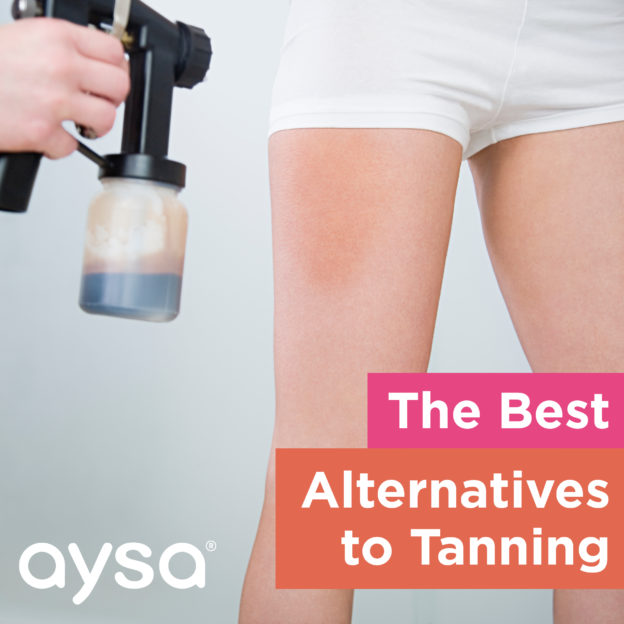It’s no secret that tanning of any kind is bad for your health. According to the Melanoma Research Foundation1, using tanning beds before age 30 increases your risk of developing melanoma by 75 percent. In fact, the World Health Organization’s International Agency for Research on Cancer classifies tanning beds in the same category as other hazardous substances such as asbestos and plutonium. So, what are you to do if you still want that sun-kissed glow without the health risks? Here are a few sunless alternatives to tanning beds:
Spray Tans
Most sunless tanners use the coloring agent DHA (dihydroxyacetone) to produce a darker skin color2. This ingredient causes a reaction involving the outermost, dead cell layer of the skin. Combining with the skin’s amino acids, it results in a “tan” that is much safer than a UV tan.
A large concern with sunless tanning is that a fake tan might leave your skin looking unnatural. However, if done right, a fake tan can look just like the real thing. Here are a few tips from Allure3 on how to prepare for your spray tan and keep it natural looking and long-lasting:
- Prepare yourself. The morning before your appointment, use a nonoily scrub to exfoliate the skin, and coat scabs and scars with Vaseline.
- If you use a retinoid or take Accutane, talk to your doctor about how this might affect your spray tan results.
- If you’re using a spray tan booth, put a light layer of lotion on the soles of your feet, between your toes and fingers, and on your palms, knees, and elbows. This will help ensure a more even tan.
- Avoid letting your skin get wet for eight hours and exfoliating for at least a week.
- Moisturize generously after you shower.
Self-Tanners
At-home tanning products come in many forms: lotions, towelettes, and creams to name a few! With so many choices, it can be intimidating and difficult to figure out which sunless tanning method is the best. WebMD has a helpful list of different types of self-tanning and what each is best for4:
- Self-tanning moisturizers: With a lower concentration of dihydroxyacetone (DHA), the active ingredient in sunless tanners, these gradually build a sun-kissed glow with daily use.
Best for: Achieving just a hint of color; a good starting step for novice self-tanners. - Tanning towelettes: Presoaked with self-tanner, these sheets just need to be unfolded and swiped across skin for an even glow.
Best for: Keeping up your glow on vacation. These pads are stress-free. “It’s almost impossible to apply too much product with tanning wipes,” says Tamar Vezirian, a New York makeup artist who runs a tanning salon and mobile tanning service. She’s helped some models in the Sports Illustrated swimsuit issue get their golden glow. - Self-tanning lotions and creams: The workhorse of sunless tanning, these formulas are often tinted so you can see if you’ve missed any spots.
Best for: Both practiced and beginner tanners. Because these formulas don’t absorb into the skin instantly, you have a few extra seconds to blend. - Sunless mousses and gels: Lightweight and fast drying, these formulas are easy to layer, so you can build coverage or customize for contouring.
Best for: Experienced self-tanners. You need to blend fast before the color is absorbed. - Do-it-yourself tanning sprays: The fastest way to cover large areas. Technique matters: You need to apply evenly from about 6 inches away in a circular motion.
Best for: Hitting hard-to-reach areas like your back. “These dispense just a light mist of color so you can achieve results that are like an airbrushed tan,” Vezirian says.
The benefits of a sunless tan are immense. Choosing to avoid UV tanning will help avoid many skin issues such as wrinkles, age spots, premature aging, and skin cancer. Don’t fear the “fake” tan — embrace healthier skin.
Everyone will likely face a skin issue in their lifetime. With the snap of a picture, Aysa is here to answer all of your questions and give guidance on what to do next. Download our app today!
References
- Why is tanning dangerous? Melanoma Research Foundation. https://www.melanoma.org/understand-melanoma/preventing-melanoma/why-is-tanning-dangerous. Accessed April 19, 2019.
- Venosa A. Fake it to Make it: Sunless Tanning Explained. Sun & Skin News From The Skin Cancer Foundation. https://blog.skincancer.org/2017/08/29/sunless-tanning-explained/?utm_source=skincancer.org&utm_campaign=blog. Published August 29, 2017. Accessed April 19, 2019.
- Pergament D. How to Get the Best Spray Tan. Allure. https://www.allure.com/story/get-the-best-spray-tan. Published May 26, 2009. Accessed April 19, 2019.
- Levitt S. Sunless Tanners: How to Choose and Use Them. WebMD. https://www.webmd.com/beauty/features/sunless-tanner#1. Published 2013. Updated October 6, 2014. Accessed April 19, 2019.

